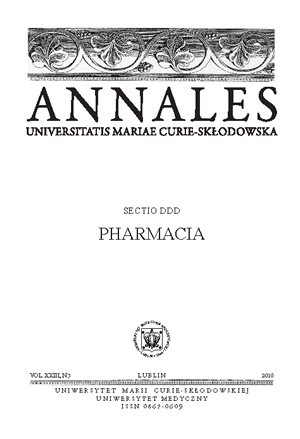Breast cancer – epidemiological and social problem in Poland
Keywords:
breast cancer, epidemiology, risk factorsAbstract
Breast cancer is the most common female malignant neoplasm. Early diagnostics and effective preventive treatment help decrease the mortality rates by 30%. An estimated 55000 Polish suffer from breast cancer. Annually, about 13500 new cases are diagnosed (42/100000 residents). Mortality rate is currently 15/100000. In recent years a stabilisation in the mortality rate despite its increasing incidence, which is thought to be the result of early diagnosis and treatment of this type of cancer has been observed. However, the number of woman participaring in population preventive screening tests is still too low and five - year survival rates are around 72% for woman in Poland estimate based on diagnoses up to the end of 2006.
References
1. Sasco A. Epidemiology of breast cancer: an environmental disease? APMIS. 2001, 109: 321-332.
2. Verdecchia A. et al. Recent cancer survival in Europe: a 2000-02 period analysis of EUROCARE-4f date Working Group. Lancet Oncol. 2007, 8: 784-796.
3. Brinton L.A. Ways that women may possibility reduce their risk of breast cancer. J. Natl. Cancer Inst. 1994, 86: 1371.
4. Rzymowska J. Morfologiczne, molekularne i biochemiczne aspekty neoadiuwantowej chemioterapii Ansfielda stosowanej w leczeniu raka piersi. PWZN, Lublin, 2002, 5: 183.
5. Chu K.C. et al. Recent trends in US breast cancer incidence, survival and mortality rates. J. Natl. Cancer Inst. 1996, 88: 1571-1579.
6. Jansen R.L.H. et al. Relevance of expression of Bcl-2 in combination with p53 as a prognostic factor in breast cancer. Anticancer Res. 1998, 18: 4455-4462.
7. Krzakowski M. Rak piersi. Zalecenia diagnostyczno-terapeutyczne Polskiej Unii Onkologii. Nowotwory. Journal of Oncology. 2003, 53: 300-324,.
8. Wojciechowska U. et al. Nowotwory złośliwe w Polsce w 2006 roku. Centrum Onkologii – Instytut, Warszawa, 2008.
9. Anttila A., Ronco G. Working Group on the Registration and Monitoring of Cervical Cancer Screening Programs in the European Union; within the European Network for Information on Cancer (EUNICE). Eur. J. Cancer. 2009, 2685: 708.
10. Krzakowski M. Zalecenia postępowania diagnostyczno-terapeutycznego w nowotworach złośliwych u dorosłych. Polska Unia Onkologii, Warszawa, 2003: 108-140,.
11. Pawlicki M. Rak piersi – nowe nadzieje i możliwości leczenia. α-medica press, Bielsko-Biała, 2002: 27.
12. Dimitrov S.D. et al.: Expression of BRCA1, NBR1 and NBR2 genes in human breast cancer cells. Folia Biol. 2001, 47: 120-127.
13. Beenken S.W., Bland K.I. Breast cancer: cellular, biochemical, and molecular biomarkers. In: Cameron J.: Current surgical therapy. Mosby, St Louis, 2001: 697-701.
14. Pieńkowski T. Rak piersi. In: Krzakowski M. Onkologia kliniczna. Wyd. Medyczne Borgis. 2001: 87-139.
15. Pawlęga J. Epidemiologia. In: Jassem J.: Rak sutka. Springer PWN, Warszawa, 1998: 31-59.
16. Silverstein M.J. Ductal carcinoma in situ of the breast. Br. J. Surg. 1997, 84: 145-146.
17. Leonard G. D., Swain S.M. Ductal carcinoma In situ, compexities and challenges. J. Natl. Cancer Inst. 2004, 96: 906-920.
18. Eusebi V. et al. Long-term follow up of in situ carcinoma of the breast. Semin. Diagn. Pathol. 1994, 11: 223-235.
19. Ross R.K. et al. Effect of hormone replacement therapy on breast cancer risk: oestrogen versus oestrogen plus progestin. J. Natl. Cancer Inst. 2000, 92: 328-332.
20. Spicer D.V., Pike M.C. Sex steroids and breast cancer prevention. Natl. Cancer Inst. Monogr. 1994, 16: 139.
21. Pujol P. et al. Rising levels of oestrogen receptors in breast cancer decades. Cancer, 1994, 74: 1601.
22. Schairer C. et al. Menopausal oestrogen and oestrogen-progestin replacement therapy and breast cancer risk. JAMA. 2000, 283: 485-491.
23. Brewster A., Helzlsouer K. Epidemiology, prophylaxis and early diagnosis in breast cancer. C. O. Oncol. 2001, 13: 420-425.
24. Marchbanks P.A. et al. Oral contraceptives and the risk of breast cancer. N. Eng. J. Med. 2002, 346: 2025-2032.
25. Beral V. et al. Breast cancer and breastfeeding: collaborative reanalysis of individual data from 47 epidemiological studies in 30 countries, including 50302 women with breast cancer and 96973 women without the disease. Lancet. 360, 2002, 187-195.
26. Holmes M.D., Wilett W.C.: Does diet affect breast cancer risk? Breast Cancer Res. 2004, 6: 170-178.
27. McPherson K. et al. Breast cancer epidemiology, risk factors and genetics. BMJ. 1994, 309: 1003.
Downloads
Published
Issue
Section
License
Copyright (c) 2010 Authors

This work is licensed under a Creative Commons Attribution-NonCommercial-NoDerivatives 3.0 Unported License.


